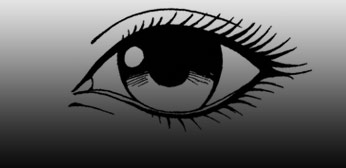Nystagmus is a condition in which
the eyes cannot stand still, but constantly perform oscillating movements.

Types:
According to types of nystagmus movements we distinguish three main types of nystagmus: spontaneus, pendulous, and mixed.
Spontaneous nystagmus
Spontaneous nystagmus consists of a slow phase, followed by a fast corrective phase. It is divided by the direction of the fast phase, i.e. upbeat, downbeat, right-beating, left-beating, and periodic alternating nystagmus. Vertical spontaneous nystagmus is often a sign of the process in corpora quadrigemina, a rotation is usually a sign of the process in an extended cord.
Pendulous nystagmus
The eyes move, like the pendulum – the oscillations are equal in both directions. Pendulous congenital nystagmus is horizontal, conjugated, often with respect to the side that moves. It is often in the children with low vision.
Unlike congenital, acquired pendulous nystagmus has a horizontal, vertical and torsional component. If the horizontal and vertical component of the stage, it manifests as trending of the pendulous nystagmus. If these two components of nystagmus are not in the phase, it is seen as an elliptical or rotator nystagmus.
Mixed nystagmus
It is nystagmus which is in the primary position of the eye pendulous, and when looking in side becomes spontaneous.
Physiological types of nystagmus:
Dynamic nystagmus (nystagmus in an extreme position): normally occurs in looking far left or far right.
Opticokinetic nystagmus: it is a normal nystagmus that occurs when looking from a moving vehicle or when looking at the opticokinetic drum. This is a rotating drum with black and white stripes. If a participant sees them separated, there is a opticokinetic nystagmus. In that way are revealed simulants and an orientation to determine visual acuity in children who cannot cooperate.
Labyrinth or vestibular nystagmus: caused by stimulation of the vestibul / labyrinth or vestibular nerve. It can be caused by experimental labyrinth stimulation (rotation of the patient, warmth, etc.).
Other types of nystagmus:
Congenital nystagmus: as already mentioned, it is a horizontal spontaneous nystagmus. It is hereditary and exists from birth. It is not present during sleep.
Dissociated nystagmus: the eyes move independently of each other. It occurs in multiple sclerosis.
Latent nystagmus: occurs in one eye when the other is covered. It may be an isolated finding, but usually occurs in certain types of strabismus.
Opsiclonus: those are actually nystagmoid eye movements, and not a true nystagmus. It consists of quick spontaneous movements without the slow phase in between. Convulsions can be horizontal, or in all directions. Although opsiclonus can occur transiently in healthy infants, it is usually a sign of the disease of the central nervous system or the result of taking certain drugs acting on central nervous system.
Treatment:
Treatment of amblyopia (visual impairment, which cannot be corrected with a correction lenses), balancing of the binocular vision and correction of torticollis (involuntary compensatory head position).




 July 16, 2012
July 16, 2012